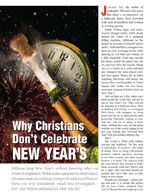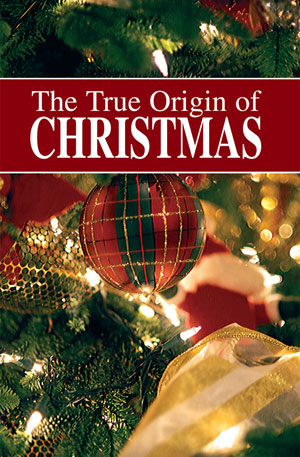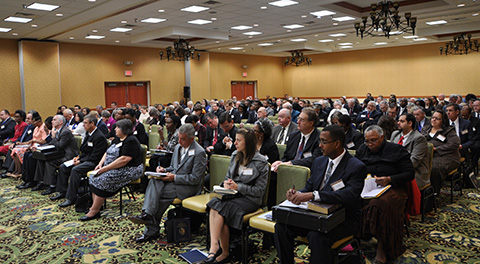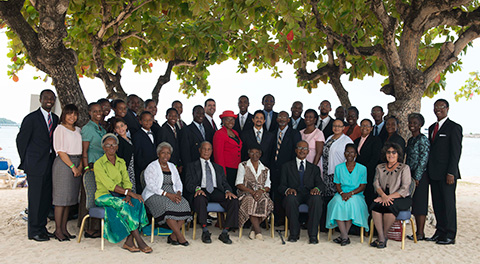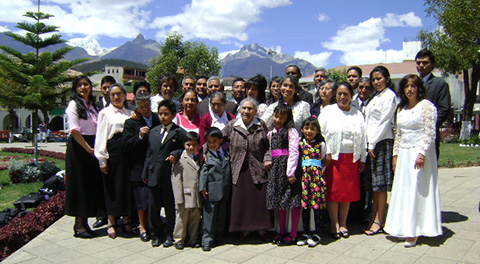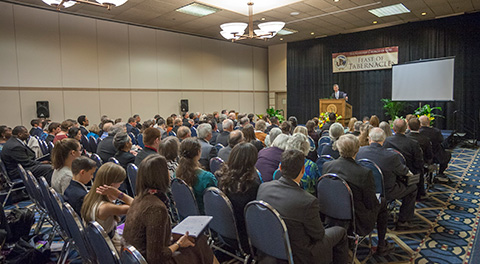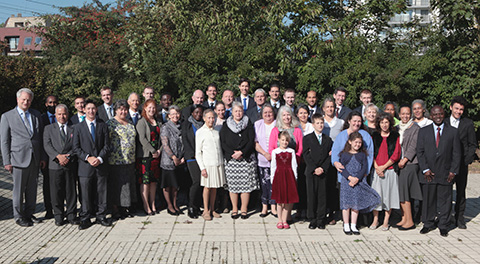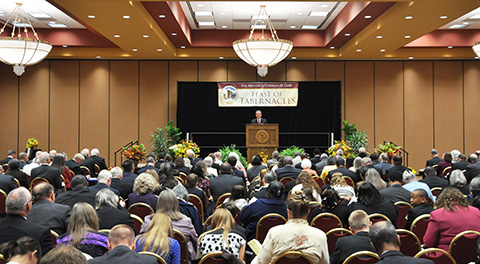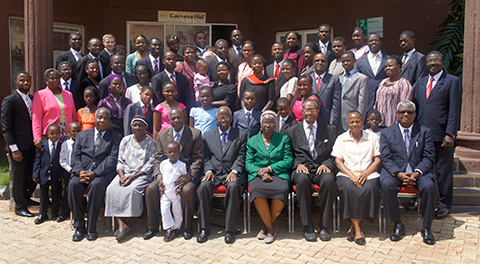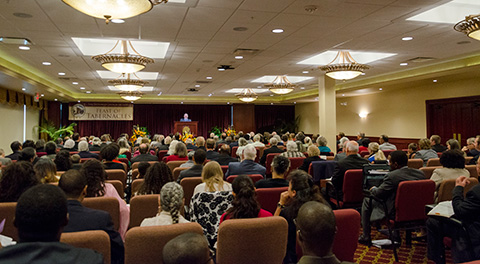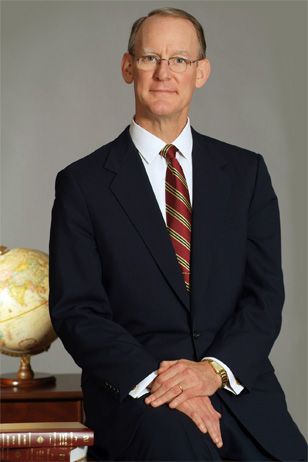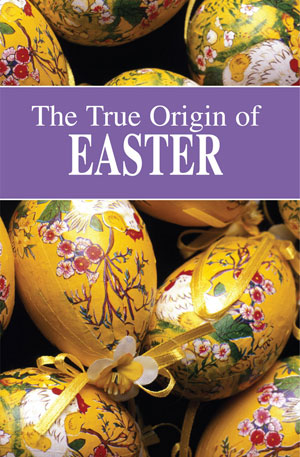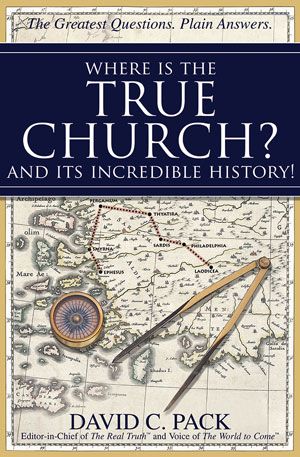Every year after Thanksgiving, most people’s thoughts turn to Christmas. It is the time when professing Christians are supposed to focus on Jesus Christ. After all, it is the “Christ-mass” season!
Rudolph the Red-nosed Reindeer, holly wreaths, decorated trees, mistletoe, season’s greetings, seasonal music, “chestnuts roasting on an open fire” and Santa Claus are all associated with this holiday. These all bring warm feelings to those who celebrate it.
I grew up in a family that kept Christmas, and it was a very big event in our household every year. We left out none of the usual trimmings of this occasion. On December 24th, excitement grew with every passing minute. My parents even brewed black coffee for Santa just before sending us off to bed. I always wondered how they knew Santa liked his coffee black—just like my parents liked theirs. After going to bed on Christmas Eve, I could neither sleep nor wait to get up in the morning to see all that “Santa” had brought me.
Christmas is thought by most to be a wonderful time, focusing the participants on giving, family togetherness, beautiful music and decorations, feasting on special foods and singing Christmas carols throughout the neighborhood (as my family did every year). All of this is supposedly centered around the worship of Christ. Surely the Bible instructs us to do all this—right?
The answers will shock you!
Why do people think that Christmas is wonderful? It certainly felt wonderful to me. I trusted what my parents told me. I had no reason to doubt them. They were merely teaching me what their parents had taught them. I never questioned the true origin of Christmas!
Most never reflect on why they believe what they believe or do what they do. We live in a world filled with customs, but few ever seek to understand their origin. We generally accept them without question. Most people basically do what everyone else does—because it is easy and natural!
Let’s carefully examine the roots of Christmas. Let’s look at why people follow the customs associated with it. Why is it kept on December 25th? Did the early New Testament Church keep it? This booklet is filled with facts from history that, when placed together, paint a complete picture. Let’s avoid all assumptions and only accept what can be proven!
Pagan Origin
In 1990, the Solon, Ohio (a Cleveland suburb) school board banned all nativity and other Christmas scenes on any school property because they felt it violated the separation of church and state. They were challenged in court when outraged parents opposed them, feeling that Christmas was being stolen from their children and the community. The board lost the case! The citizenry had contended that Christmas was a worldwide tradition that was not part of, and transcended, religion. It was deemed to be secular—a part of virtually all cultures worldwide.
The court decision affirmed that Christmas has no Christian roots! However, the court’s opinion also noted that Bible reading and prayer obviously are associated with Christianity—a remarkable admission! The court concluded that Christmas-keeping and manger scenes could remain because they are not really part of either Christianity or religion—but prayer and Bible reading, which are, must remain excluded from schools!
Nearly all aspects of Christmas observance have their roots in Roman custom and religion. Consider the following admission from a large American newspaper (The Buffalo News, Nov. 22, 1984): “The earliest reference to Christmas being marked on Dec. 25 comes from the second century after Jesus’ birth. It is considered likely the first Christmas celebrations were in reaction to the Roman Saturnalia, a harvest festival that marked the winter solstice—the return of the sun—and honored Saturn, the god of sowing. Saturnalia was a rowdy time, much opposed by the more austere leaders among the still-minority Christian sect. Christmas developed, one scholar says, as a means of replacing worship of the sun with worship of the Son. By 529 AD, after Christianity had become the official state religion of the Roman Empire, Emperor Justinian made Christmas a civic holiday. The celebration of Christmas reached its peak—some would say its worst moments—in the medieval period when it became a time for conspicuous consumption and unequaled revelry.”
Consider these quotes from the Catholic Encyclopedia, 1911 edition, under “Christmas”: “Christmas was not among the earliest festivals of the Church…The first evidence of the feast is from Egypt.” Further, “Pagan customs centring round the January calends gravitated to Christmas.” Under “Natal Day,” Origen, an early Catholic writer, admitted, “…In the Scriptures, no one is recorded to have kept a feast or held a great banquet on his birthday. It is only sinners (like Pharaoh and Herod) who make great rejoicings over the day on which they were born into this world” (emphasis mine).
The Encyclopedia Americana, 1956 edition, adds, “Christmas…was not observed in the first centuries of the Christian church, since the Christian usage in general was to celebrate the death of remarkable persons rather than their birth…a feast was established in memory of this event [Christ’s birth] in the 4th century. In the 5th century the Western church ordered the feast to be celebrated on the day of the Mithraic rites of the birth of the sun and at the close of the Saturnalia, as no certain knowledge of the day of Christ’s birth existed.”
There is no mistaking the origin of the modern Christmas celebration. Many additional sources could be cited and we will return to this later. Let’s begin to tie some other facts together.
It was 300 years after Christ before the Roman church kept Christmas, and not until the fifth century that it was mandated to be kept throughout the empire as an official festival honoring “Christ.”
Can Christ be Honored by Christmas?
The most common justification that one will hear regarding Christmas is that people have replaced old pagan customs and intents by asserting that they are now “focusing on Christ.” I have heard many say that they are “honoring Christ” in their Christmas-keeping. The problem is that God does not say this is acceptable to Him! Actually, He plainly commands against it! Keeping Christmas dishonors Christ! He considers everything about it to be an abomination! We will soon see why.
Christ said, “But in vain they do worship Me, teaching for doctrines the commandments of men” (Matt. 15:9). Christmas is not a command of God—it is a tradition of men. Christ continued, “Full well you reject the commandment of God, that you may keep your own tradition” (Mark 7:9). Every year, throughout the world, on December 25th, hundreds of millions do just that!
We will see that God plainly commands, “Follow not the way of the heathen.” But most people do not fear God, and He allows them to make their own decisions. Human beings are free moral agents—free to obey or disobey God! But woe to those who ignore the plain Word of God!
Was Christ Born on December 25th?
Christ was born in the fall of the year. Many have mistakenly believed He was born around the beginning of winter—December 25th! They are wrong! Notice the Adam Clarke Commentary, volume 5, page 370, New York edition: “It was custom among Jews to send out their sheep to the deserts about the Passover [early spring], and bring them home at the commencement of the first rain.” The first rains began in early-to-mid fall. Continuing with this same quote: “During the time they were out, the shepherds watched them night and day. As…the first rain began early in the month of March-esvan, which answers to part of our October and November [begins sometime in October], we find that the sheep were kept out in the open country during the whole summer. And as these shepherds had not yet brought home their flocks, it is a presumptive argument that October had not yet commenced, and that, consequently, our Lord was not born on the 25th of December, when no flocks were out in the fields; nor could He have been born later than September, as the flocks were still in the fields by night. On this very ground, the nativity in December should be given up. The feeding of the flocks by night in the fields is a chronological fact…See the quotations from the Talmudists in Lightfoot.”
Luke 2:8 explains that when Christ was born, “And there were in the same country shepherds abiding in the field, keeping watch over their flock by night.” Note that they were “abiding” in the field. This never happened in December. Both Ezra 10:9-13 and the Song of Solomon 2:11 show that winter was the rainy season and shepherds could not stay on cold, open fields at night.
Numerous encyclopedias plainly state that Christ was not born on December 25th! The Catholic Encyclopedia directly confirms this. In all likelihood, Christ was born in the fall! A lengthy technical explanation would prove this point.
Since we now know that December 25th was nowhere near Christ’s actual birthdate, where did the festival associated with this date come from?
Now read this quote under “Christmas”: “In the Roman world the Saturnalia (December 17) was a time of merrymaking and exchanging of gifts. December 25 was also regarded as the birth date of the Iranian mystery god Mithra, the Sun of Righteousness. On the Roman New Year (January 1), houses were decorated with greenery and lights, and gifts were given to children and the poor. To these observances were added the German and Celtic Yule rites when the Teutonic tribes penetrated into Gaul, Britain, and central Europe. Food and good fellowship, the Yule log and Yule cakes, greenery and fir trees, gifts and greetings all commemorated different aspects of this festive season. Fires and lights, symbols of warmth and lasting life, have always been associated with the winter festival, both pagan and Christian” (Encyclopaedia Britannica, 15th Edit. Vol. II, p. 903).
A final quote about the selection of December 25th as the birthdate of Christ is necessary. Note an article in The Toronto Star, December 1984, by Alan Edmonds, entitled, “We owe a lot to Druids, Dutch”: “The Reformation cast a blight on Christmas. By then, of course, clever ecclesiastical politicians had adopted the Pagan mid-winter festival as the alleged birthdate of Jesus, of Nazareth, and thrown in a few other Pagan goodies to make their takeover more palatable.”
December 25th was not selected because it was the birth of Christ or because it was even near it. It was selected because it coincided with the idolatrous pagan festival Saturnalia—and this celebration must be carefully examined. In any event, we do not know the exact date of Christ’s birth. While God certainly could have made it known, He chose to hide it from the world’s eyes!
Who Was Saturn?
Previous quotes introduced the subject of the Saturnalia. Let’s carefully study just exactly who Saturn was. Consider the following quote from another large American newspaper, The Democrat and Chronicle, Rochester, New York, December 1984: “The Roman festival of Saturnalia, Dec. 17-24, moved citizens to decorate their homes with greens and lights and give gifts to children and the poor. The Dec. 25 festival of natalis solis invicti, the birth of the unconquered sun, was decreed by the emperor Aurelian in AD 274 as a Winter Solstice celebration, and sometime (later)…was Christianized as a date to celebrate the birth of the Son of Light.”
Dr. William Gutsch, chairman of the American Museum of Natural History—Hayden Planetarium, further confirmed the original name of Christmas with this quote on December 18, 1989, in a Westchester, New York, newspaper, The Reporter Dispatch:
“The early Romans were not celebrating Christmas but rather a pagan feast called the Saturnalia. It occurred each year around the beginning of winter, or the winter solstice. This was the time when the sun had taken its lowest path across the sky and the days were beginning to lengthen, thus assuring another season of growth.
“If many of the trappings of the Saturnalia, however, seem to parallel what so many of us do today, we can see where we borrowed…our holiday traditions. And indeed, it has been suggested that while Christ was most likely not born in late December, the early Christians—then still an outlawed sect—moved Christmas to the time of the Saturnalia to draw as little attention as possible to themselves while they celebrated their own holiday.”
The Saturnalia, of course, celebrated Saturn—the fire god. Saturn was the god of sowing (planting) because heat from the sun was required to allow for planting and growth of crops. He was also worshipped in this dead-of-winter festival so that he would come back (he was the “sun”) and warm the earth again so that spring planting could occur. The planet Saturn was later named after him because, among all of the planets, with its rings and bright red color, it best represented the god of fire!
Virtually every civilization has a fire/sun god. The Egyptians (and sometimes Romans) called him Vulcan. The Greeks named him Kronos, as did the Phoenicians—but they also called him Saturn. The Babylonians called him Tammuz (as Nimrod, resurrected in the person of his son), Molech or Baal (as did the Druids). These were all simply the various names for Nimrod. Nimrod was considered the father of all the Babylonian gods.
Child Sacrifice
Notice this horrible practice associated with the worship of the fire god (Nimrod, Saturn, Kronos, Molech and Baal) in the following quote from The Two Babylons, Alexander Hislop, page 231:
“Now, this is in exact accordance with the character of the Great Head of the system of fire-worship. Nimrod, as the representative of the devouring fire to which human victims, and especially children, were offered in sacrifice, was regarded as the great child-devourer…he was, of course, the actual father of all the Babylonian gods; and, therefore, in that character he was afterwards universally regarded. As the Father of the gods, he was, as we have seen, called Kronos; and every one knows that the classical story of Kronos was just this, that, ‘he devoured his sons as soon as they were born.’ (Lempriere Classical Dictionary, ‘Saturn.’)…This legend has a further and deeper meaning; but, as applied to Nimrod, or ‘The Horned One,’ it just refers to the fact, that, as the representative of Moloch or Baal, infants were the most acceptable offerings at his altar. We have ample and melancholy evidence on this subject from the records of antiquity. ‘The Phoenicians,’ says Eusebius, ‘every year sacrificed their beloved and only-begotten children to Kronos or Saturn.’”
But why was human sacrifice such a key to the worship of this terrible god? What possible good could human beings think they saw in slaughtering their own children? Continuing: “…he who approached the fire would receive a light from divinity” and “through divine fire all the stains produced by generations could be purged away.” Therefore, “children were made to pass through the fire unto Molech” (Jer. 32:35).
As incredible as it seems, deceived human beings actually believed they were pleasing their “god” by sacrificing their own innocent little children to him. They believed fire purified them from original sin. The pagan doctrine of spending time in purgatory to purge the soul from all sin derives from this belief!
Who Was Nimrod?
We must now look more closely at who this biblical figure, Nimrod, was. We have already seen him as one of history’s original false gods, but what else can be learned?
Genesis 10:9 says of Nimrod, “He was a mighty hunter before [in place of] the Lord.” He actually tried to replace God.
The famous Jewish historian, Josephus, records in Josephus Antiquities important evidence of Nimrod’s role in the post-flood world. Notice: “He also gradually changed the government into tyranny…He [Nimrod] also said he would be revenged on God, if He should have a mind to drown the world again; for that he would build a tower too high for the waters to be able to reach…Now the multitude were very ready to follow the determination of Nimrod, and to esteem it a piece of cowardice to submit to God” (Bk. I, Ch. IV, sec. 2, 3).
Under many names, mankind’s earliest and perhaps greatest rebel has been worshipped throughout false religion. Ancient Israel kept falling into serving the many false gods that Nimrod represented.
Ezekiel 8:13-14 records a picture of the women of Israel “weeping for Tammuz.” This Tammuz (the god of fire) was considered to be Nimrod and the etymology of the word itself is fascinating. Tam means “to make perfect” and muz “fire.” The meaning is clear in light of what we have already learned. Incidentally, in the Iraqi-Kuwaiti Desert Storm War, Saddam Hussein even named one of his missiles the “Tammuz.” He certainly understood that its meaning included fire.
Burned to Molech
Let’s see how God’s people, Israel, worshipped Baal/Molech once they had departed from the true God: “And they built the high places of Baal, which are in the valley of the son of Hinnom, to cause their sons and their daughters to pass through the fire unto Molech; which I commanded them not, neither came it into My mind, that they should do this abomination…” (Jer. 32:35).
Notice that God Himself says that such horrible abominations never even entered His mind: “They have built also the high places of Baal, to burn their sons with fire for burnt offerings unto Baal, which I commanded not, nor spoke it, neither came it into My mind: Therefore, behold, the days come, says the Lord, that this place shall no more be called Tophet, nor The valley of the son of Hinnom, but the valley of slaughter” (Jer. 19:5). Verse 6 ties the valley of Tophet or Hinnom to this practice. Jeremiah 7:31 connects Tophet and Hinnom to child sacrifice. Tophet means “the drum.” Drums were played to drown the screams of victims in the flames.
Notice this quote from Paradise Lost, by John Milton, about the terrible god Molech: “First Moloch, horrid king besmear’d with blood Of human sacrifice, and parents tears, Though, for the noyse of Drums and Timbrels loud Their children’s cries unheard, that passed through fire To his grim Idol.” Of course, everyone will say that they do not sacrifice their children to Molech today, but read on.
In the New Testament, the martyr Stephen was stoned to death, at least partly, because he indicted his listeners for the worship of this evil idol (Acts 7:43).
When righteous King Josiah came to the throne, as king of Judah, he destroyed the altars in the Valley of Tophet (or Hinnom—the very same valley Christ likened to “gehenna” fire in Mark 9:43-49) soon after coming to power. He realized the great evil of the practices taking place there.
The Druids and Human Sacrifice
Many people have heard of the Druids. Few know who and what they were. We will refer to them later and tie them to other well-known Christmas practices. We must first establish their historic role in human sacrifice.
Julius Caesar is the best-known source of information about the Druids. This comes from the Encyclopaedia Britannica. This quote, under “Druids,” clearly explains who they were: “Druids, the learned class among the ancient Celts, whose name means Knowing (or Finding) the Oak Tree. They seem to have frequented Oak forests and acted as priests, teachers and judges. The earliest known records of the Druids come from the 3rd century [B.C.]…Druids took charge of public and private sacrifices, and many young men went to them for instruction. They judged all public and private quarrels and decreed the penalty…The Druids principle doctrine was that the soul was immortal…(they) offered human victims for those who were gravely sick or in danger of death in battle. Huge wickerwork images were filled with living men and then burned; although the Druids chose criminals by preference, they sacrificed innocent victims if necessary.”
The Old Testament is filled with God’s condemnation of Israel for practicing the customs of the nations around them—and we are gathering important facts revealing a shocking picture. (To learn more about this subject, read our booklet God’s Holy Days or Pagan Holidays?)
The Role of Cannibalism
Another truth about the origin of Christmas springs from the modern word cannibal. This practice has its roots in a prime function of all priests of Baal. Keep in mind that the Hebrew word for priest is Cahn.
Consider the following quote from The Two Babylons, by Alexander Hislop, page 232: “And it was a principle of the Mosaic law, a principle no doubt derived from the patriarchal faith, that the priest must partake of whatever was offered as a sin-offering (Numbers xviii. 9, 10). Hence, the priests of Nimrod or Baal were necessarily required to eat of the human sacrifices; and thus it has come to pass that ‘Cahna-Bal,’ the ‘Priest of Baal,’ is the established word in our own tongue for a devourer of human flesh.”
The reality of this can be lost on no one! It is also true that most civilizations have a tradition that has involved cannibalism. Notice this statement from The New York Times, “What Is the Meaning of Cannibalism?” by Erik Eckholm: “Cannibalism has once fascinated and repelled virtually every known society, including those said to have practiced it.”
This same article went on to show that most civilizations also attached divine significance to its practice.
What About the Santa Myth?
Have you considered that you could also be burning, even sacrificing, your children today (though in a different way) in your practice of Christmas, while you may be trying to sincerely “focus on Christ”?
Parents reason that they owe the whole Christmas myth to their children! Christmas traditions are focused primarily on kids, and they are certainly the center of most of what happens. I know because I kept seventeen Christmases. My older sister and younger brother and I were the recipients of much and the givers of very little on that day—and it all started with the Santa Claus lie.
Some years ago, a priest in New Jersey told his Sunday school class that Santa was a myth. The outrage from parents and his supervisors was swift. He had “killed Santa!” He had “destroyed family tradition!” He had “usurped family authority,” the article continued. He was officially censored by his superiors for being “overzealous and insensitive.”
His crime? He told the truth!
According to Langer’s Encyclopedia of World History, (article “Santa”), “Santa” was a common name for Nimrod throughout Asia Minor. This was also the same fire god who came down the chimneys of the ancient pagans and the same fire god to whom infants were burned and eaten in human sacrifice among those who were once God’s people.
Today Santa Claus comes from “Saint Nicholas.” Washington Irving, in 1809, is responsible for remaking the original old, stern bishop of this same name into the new “jolly St. Nick” in his Knickerbocker History of New York. (Most of the rest of America’s Christmas traditions are even more recent than this.) “Old Nick” has long been recognized as a term for the devil.
In Revelation 2:6 and 15, we read about a “doctrine of the Nicolaitanes,” which Christ twice tells His Church “[He] hates.” Let’s analyze the word Nicolaitane. It means “follower of Nicholas.” Nikos means “conqueror, destroyer.” Laos means, “people.” Nicolaitanes, then, are people who follow the conqueror or destroyer—Nimrod. If you have believed that following Christmas is an innocent Christian custom, let this truth sink in!
Is It Scriptural to Exchange Gifts?
Merchants regularly report that over 60% of their annual retail sales occur during the Christmas shopping season. This represents a tremendous amount of gift buying. Most today believe that gift-giving comes from the Bible example of the “three wise men” (the Bible gives no number) presenting gifts to Christ. Is this true? Where did exchanging gifts come from, and what does God’s Word say about it?
The Bibliotheca Sacra states, “The interchange of presents between friends is a like characteristic of Christmas and the Saturnalia, and must have been adopted by Christians from the pagans, as the admonition of Tertullian plainly shows” (Vol. 12, pp. 153-155).
Like every other aspect of Christmas, the shocking truth is that even this supposed Christian custom does not come from the Bible. It is an irony that people love to believe they are following the custom of the wise men giving to Christ, when actually they are giving almost exclusively to each other! What hypocrisy! Christ is completely forgotten.
The Bible actually teaches that Christians should not keep birthdays. Numerous scriptures make this principle clear. (Our article “Are Birthday Celebrations Christian?” expands on this subject.) However, what if you went to a birthday party that had been prepared for you and everybody gave gifts to each other and you were left out? The idea is ridiculous! If this happened, you would say that people were being selfish and forgetting you. In fact, most people give to others on Christmas merely because they expect to receive gifts themselves!
Let’s briefly return to the “wise men” who gave gifts to Christ. The scripture describing this is Matthew 2:1-11: “Now when Jesus was born in Bethlehem of Judaea in the days of Herod the king, behold, there came wise men from the east to Jerusalem, saying, Where is He that is born King of the Jews?…And when they were come into the house, they saw the young Child with Mary His mother, and fell down, and worshipped Him: and when they had opened their treasures, they presented unto Him gifts; gold, and frankincense, and myrrh.”
It is commonly supposed that these were birthday presents for “baby Jesus.” But is this what the Bible actually says? Absolutely not! First, it is important to note that they did give the gifts to Jesus. They did not stand in His presence and exchange gifts among themselves or give them to others. The gifts were “presented unto Him.” Also, they arrived well after His “birthday.” This is another reason these could not have been “birthday presents.”
A long-standing, ancient custom of the East was to present gifts when coming before a king. These men understood they were in the presence of the “King of the Jews.” The Bible carries many examples of people sending gifts to kings or presenting them upon arrival into their presence. This custom is common today when ambassadors or others come into the presence of a world leader.
Finally, notice what the Adam Clarke Commentary, volume 5, page 46, states about what really happened on this occasion: “Verse 11. They presented unto him gifts. The people of the east never approach the presence of kings and great personages, without a present in their hands. This custom is often noticed in the Old Testament, and still prevails in the east, and in some of the newly discovered South Seas Islands.” Gifts were customarily presented to kings.
What could be more plain?
The Origin of the Christmas Tree
No booklet about Christmas is complete without some explanation of the “Christmas tree.” We have touched on it without directly focusing on it. The modern Christmas tree originated in Germany. But the Germans got it from the Romans, who got it from the Babylonians and the Egyptians.
The following demonstrates what the Babylonians believe about the origin of the Christmas tree: “An old Babylonish fable told of an evergreen tree which sprang out of a dead tree stump. The old stump symbolized the dead Nimrod, the new evergreen tree symbolized that Nimrod had come to life again in Tammuz! Among the Druids the oak was sacred, among the Egyptians it was the palm, and in Rome it was the fir, which was decorated with red berries during the Saturnalia!” (Walsh, Curiosities of Popular Customs, p. 242).
Frederick J. Haskin’s Answers to Questions states, “The Christmas tree is from Egypt, and its origin dates from a period long anterior to the Christian Era.” Did you know this—that the Christmas tree long preceded Christianity?
Most aspects of Christmas are not referred to in the Bible. Of course, the reason is that they are not from God—they are not part of the way He wants people to worship Him. The Christmas tree, however, is directly mentioned in the Bible! Turn to Jeremiah 10:2-5, “Thus says the Lord, Learn not the way of the heathen…For the customs of the people are vain: for one cuts a tree out of the forest, the work of the hands of the workman, with the axe. They deck it with silver and with gold; they fasten it with nails and with hammers, that it move not. They are upright as the palm tree, but speak not: they must needs be borne, because they cannot go. Be not afraid of them; for they cannot do evil, neither also is it in them to do good.”
This plain description of the modern Christmas tree is clear. God directly refers to it as “the way of the heathen.” Just as directly, He commands His people to “learn not the way of the heathen,” calling these customs “vain.” Verse 23 adds a remarkable and powerful statement: “O Lord, I know that the way of man is not in himself: it is not in man that walks to direct his [own] steps.” God must teach people how to live. Man simply cannot figure out God’s ways for himself.
There is no room in Jeremiah 10 to believe, as some have tried to suggest, that because these trees are powerless of themselves, it is not really forbidden to have a Christmas tree. God condemns the putting up of pagan (Christmas) trees with this plain Bible command!
The Source of Holly Wreaths, Yule Logs and Mistletoe
The Encyclopedia Americana states, “The holly, the mistletoe, the Yule log…are relics of pre-Christian times.” In other words, paganism! The Yule log was commonly used in a rite of Teutonic nature worship.
Frederick Haskin further states, “The use of the Christmas wreath is believed by authorities to be traceable to the pagan custom of decorating buildings and places of worship at the feast which took place at the same time as our Christmas.”
The Encyclopaedia Britannica, under “Celastrales,” exposes the origin of the holly wreath: “European pagans brought holly sprays into their homes, offering them to the fairy people of the forests as refuges from the harsh winter weather. During the Saturnalia, the Roman winter festival, branches of holly were exchanged as tokens of friendship. The earliest Roman Christians apparently used holly as a decoration at the Christmas season.”
There are dozens of different types of holly. Virtually all of them come in male and female varieties—such as “Blue Prince and Blue Princess” or “Blue Boy and Blue Girl” or “China Boy and China Girl.” Female holly plants cannot have berries unless a nearby male plant pollinates them. It is easy to see why the holly wreath found its way into pagan rituals as a token of friendship and fertility!
Christmas is incomplete to many unless it involves “kissing under the mistletoe.” This pagan custom was natural on a night that involved much revelry done in the spirit of drunken orgies. Just like today, this “kissing” usually occurred at the beginning of the Saturnalia/Christmas celebration. I will never forget having to always kiss my friends’ mothers upon entering each of their houses every Christmas. It was the first thing that we did. I hated it—but it was something I “had to do”! Mistletoe was considered to have special powers of healing for those who “reveled” under it.
The Encyclopaedia Britannica, under “Santalales,” states, “The European mistletoe is thought to have had special ritual significance in Druidical ceremonies and lives in folklore today, its special status as the Christmas mistletoe having come from Anglo-Saxon times.” Mistletoe is a parasite that lives on oak trees. (Recall that the Druids worshipped in oak tree groves.) The ancient Celtics (associated with the Druids) used to give mistletoe as an herbal remedy to barren animals to make them fertile. It is still referred to as “all healer” in Celtic.
Like mistletoe, holly berries were also thought to be sacred to the sun god. The original “sun log” came to be called the yule log. “Yule” simply means “wheel,” which has long been a pagan representation of the sun. No wonder people today commonly speak of the “sacred yule-tide season.”
Worship of the True God Mixed with False Practices
The modern term for merging false pagan customs with the worship of the true God is called syncretism. Anyone who did this in ancient Israel was put to death (Lev. 18:21, 29)! It was that serious!
A fascinating look into how Israel thought and believed, in their own minds, that they were worshipping God as an entire nation, comes from II Kings 17:33: “They feared the Lord, and served their own gods, after the manner of the nations whom they carried away from there.”
Did you grasp this? Yes, they feared the true God while serving other gods. No wonder the very next verse (34) states that they really “fear NOT the Lord” according to the way God commanded. This is how God views what people are doing today—no matter what these people copying ancient pagan practices might think of their own actions!
Verse 30 says that all this had been learned from contact with “the men of Babylon” (among others), whose chief god, we will recall, was Nimrod (Baal or Molech)—who we now know were one and the same.
Notice how specific was God’s warning to Israel in Deuteronomy 12:29-31, and why He warned them! “When the Lord your God shall cut off the nations from before you…and you succeed them, and dwell in their land; Take heed to yourself that you be not snared by following them, after that they be destroyed from before you; and that you enquire not after their gods, saying, How did these nations serve their gods? Even so will I do likewise. You shall not do so unto the Lord your God: for every abomination to the Lord, which He hates, have they done unto their gods; for even their sons and their daughters have they burnt in the fire to their gods.”
Many verses, similar to Deuteronomy 12, should be carefully studied. (See Exodus 34:10-17; 23:23-33; Leviticus 20:22-26; Deuteronomy 20:13-18, etc.) The true God knew that serving other gods always led to sacrificing children to them!
Deuteronomy 12:32 made clear that God does not want us to mix His ways with any false ways: “What thing soever I command you, observe to do it: you shall not add thereto, nor diminish from it.”
These are God’s plain words to all who say that they can mix the horrible customs of outright paganism with a supposed “focus on Christ.”
Ancient Israel’s Pagan Practices in Modern Customs
Deuteronomy 12:2-4 establishes an important context. God plainly says, “You shall utterly destroy all the places, wherein the nations which you shall possess served their gods, upon the high mountains, and upon the hills, and under every green tree: And you shall overthrow their altars…and burn their groves with fire…you shall not do so unto the Lord your God.”
Notice God’s references to “every green tree” and “their groves.” There are at least ten similar verses throughout the Old Testament referring to “green trees” and their association with idolatry. Historians hold that the reference to the term “green” refers to green year-round—evergreen trees!
Once again, let’s more closely examine the actual history and origins of some of the Saturnalia customs still practiced today. Notice the following chilling quote from the Dictionary of Greek and Roman Antiquities, “Oscilla” 3rd edition, volume II: “…all ranks devoted themselves to feasting and mirth, presents were exchanged among friends, and crowds thronged the streets, shouting ‘Lo Saturnalia.’ An offering was made beneath a decorated evergreen tree, according to the pagan poet, Virgil. Figurines and masks—called ‘oscilla’—were hung on the tree, as are Christmas decorations today. History admits…there can be no doubt that we have in these ‘oscilla’ a relic of human sacrifice…”
Doesn’t all of this sound familiar? Presents, singing in the streets, evergreen trees, decorations, offerings under the tree, merrymaking, feasting? They may sound wonderful, but they represent things that are truly abominable.
Modern oscilla look like chubby little “angels” when hanging on a tree. I placed these little “angel babies” on our tree, myself, as a small child. At least I thought they were angel babies. How wrong I was! Do you think any of your friends realize what they really represent? Of course not—but that does not make it any less serious or less wrong in God’s eyes!
Outright Paganism Blended into the Church
One additional source demonstrates how this all came to be a heritage practiced so “innocently” by millions—yet far from innocent in God’s sight. Now read the following quote from Encyclopaedia Britannica, 15th edition, volume 10, pages 1062-3: “Christianity…by a complex and gradual process…became the official religion of the [Roman] empire.
“For a time, coins and other monuments continued to link Christian doctrines with worship of the sun, to which Constantine had been addicted previously. But even when this phase came to an end, Roman paganism continued to exert other, permanent influences, great and small…The ecclesiastical calendar retains numerous remnants of pre-Christian festivals, notably Christmas, which blends elements including both the feast of the Saturnalia and the birthday of Mithra. But, most of all, the mainstream of Western Christianity owed ancient Rome the firm discipline that gave it stability and shape.”
An authority as reputable as the Encyclopaedia Britannica actually acknowledges, for any willing to see, that the Saturnalia and ancient Rome are what defined the “discipline…stability and shape” of Western Christianity!
This is a truly stunning admission!
The next powerful quote reveals how this idolatrous, pagan festival slipped into the “Christian” world. It is from the New Schaff-Herzog Encyclopedia of Religious Knowledge, under “Christmas”:
“How much the date of the festival depended upon the pagan Brumalia (December 25) following the Saturnalia (Dec. 17-24), and celebrating the shortest day of the year and the ‘new sun’…cannot be accurately determined. The pagan Saturnalia and Brumalia were too deeply entrenched in popular custom to be set aside by Christian influence…The pagan festival with its riot and merry-making was so popular that Christians were glad of an excuse to continue its celebration with little change in spirit and in manner. Christian preachers of the West and the Near East protested against the unseemly frivolity with which Christ’s birthday was celebrated, while Christians of Mesopotamia accused their Western brethren of idolatry and sun worship for adopting as Christian this pagan festival.”
One additional source reveals how the Roman church absorbed Christmas into an official celebration. The Encyclopaedia Britannica, 1946 edition, states, “Christmas was not among the earliest festivals of the church…Certain Latins, as early as 354, may have transferred the birthday from January 6th to December 25, which was then a Mithraic feast…or birthday of the unconquered SUN…The Syrians and Armenians, who clung to January 6th, accused the Romans of sun worship and idolatry, contending…that the feast of December 25th, had been invented by disciples of Cerinthus…”
Thus, a pagan festival, celebrated long before Christ’s birth, found its way into recognized Christianity.
Did you know that even the seventeenth century Puritans of New England understood how wrong Christmas was? They actually banned its observance by law, in 1659, throughout the Massachusetts Bay Colony. Fines and imprisonment could result from being found keeping it. It was almost 200 years (1856) before people stopped working on Christmas in Boston. The Puritans knew its roots and labeled it “heathen, papist idolatry.”
Those Who “Change Times and Laws”
The prophet Daniel (7:8) speaks of a “little horn,” which (7:25) “shall speak great words against the Most High…and think to change times and laws.” This little horn is a great religious authority that attempts to superimpose its own view of dates and celebrations, on an unsuspecting world, in place of God’s plain instruction.
The Hebrew word translated “change” means to “transform, alter or set.” The word translated “times” means “appointed occasions, seasons or times.” The Hebrew word translated “laws” means “decrees or laws of God.” When put together, this phrase refers to an authority that attempts to “transform appointed occasions and seasons within the Law of God.” Certainly, Christmas is a great example of how this has been done. God’s instructions have been replaced with religious traditions of men.
While the ultimate fulfillment of these verses is yet ahead, the following quote reveals how this has happened in the past as well. It also comes from the Encyclopaedia Britannica, under “Christianity”: “Thus, the Easter liturgy has been developed more highly in the Eastern Orthodox Church, and the Christmas liturgy more highly in the Roman Catholic Church…The Christian calendar is the most widely disseminated Christian institution. The seven-day week and the rhythm of the Christian festivals have been accepted even by most of the non-Christian countries. Despite energetic attempts at the introduction of a sliding work week, the seven-day week with work-free Sunday could not be eliminated even in Communist states with an Atheist world view. Even in Atheistic circles and organizations throughout the world, Christian holidays enjoy an undisputed popularity as work-free days…especially Christmas.”
Truly, it has been the “ecclesiastical politicians,” referred to earlier, who have sought to impose the modern “Christian” calendar on an unknowing world. It is these leaders who have “thought to change times and laws.”
The Dangerous Power of Lies
One of Satan’s names is Destroyer (Rev. 9:11). Nimrod/Saturn/Molech/Baal, like Satan, is the fire god who destroys and devours little children.
The real Jesus Christ was never in and never will be in Christmas! He cannot be put back into where He has never been. But the “god of this world,” Satan (II Cor. 4:4), has always been in Christmas. He is its author!
The true God commands that we “must worship Him in spirit and in truth” (John 4:23-24). This does not mesh with the great Christmas and Santa Claus lies that all children so willingly believe.
I Timothy 4:2 warns of those “speaking lies in hypocrisy; having their conscience seared with a hot iron.” Parents can “burn” their own children, to the point of searing them, with the Christmas deception and lie!
There is no “safety in numbers” in this world for those who keep Christmas, because Satan, who is called “the father of lies” and “a murderer from the beginning” (John 8:44), has “deceived the whole world” (Rev. 12:9)! Turn to this verse and read it. Then recognize that Christmas is certainly a testimony to that great deception.
But Christ refers to His Church as a “little flock” (Luke 12:32). Many other verses show this. This Church does not have the large numbers of the respected, established brands of the Christianity of this world.
“Another Jesus”
There is another problem with the idea of “putting Christ back in Christmas”—and it is big! The “Jesus” that is the focus of this season is not the true Jesus Christ of the Bible! (Our book The True Jesus Christ – Unknown to Christianity reveals more about this topic.)
Most have been taught that there is only one Jesus Christ. But God’s Word speaks of a counterfeit, and this substitute Christ is identifiable in history. The proof? The apostle Paul warned of “another Jesus.”
Grasp what is at stake here!
First, consider Paul’s entire introduction as he sets the stage for the warning that follows: “But I fear, lest by any means, as the serpent [Satan] beguiled Eve through his subtilty, so your minds should be corrupted from the simplicity that is in Christ” (II Cor. 11:3).
Now for the actual warning in the next verse: “For if he that comes preaches another Jesus, whom we have not preached, or if you receive another spirit, which you have not received, or another gospel, which you have not accepted, you might well bear with him” (II Cor. 11:4). The Corinthians seemed to “bear with this” without much resistance.
Paul, under inspiration of the true Jesus Christ of the Bible, was moved to record the peril of unwittingly following “another Jesus.” Consider. Most have probably never remotely considered the idea of a false Jesus for even a moment—that there is such a thing as a wrong, different and “false Christ” (Matt. 24:23-24)— called “another Jesus.” In the past, this “Jesus” has even corrupted the thinking of true Christians. This much is plain. But the “subtilty” of how this can happen, and how it has occurred in history, is so deceptive— so seductive— that even true Christians can unknowingly slip into worshipping this so- called Jesus. This is what was happening to the Corinthians.
People can worship in ways that represent things that are far different than what they sincerely believe or intend. Bible “believers” today can think that they are worshipping the true Savior when they are really worshipping a false savior—another Jesus! The entirety of traditional Christianity is actually worshipping Nimrod/Saturn/Molech/Baal. The modern mother/child “Mary/Jesus” emphasis, including the worshipful adoration of Mary by millions, is a parallel with Nimrod and his mother, Semiramis, that cannot be missed.
Here is the point of what is being explained. Many speak of “putting Christ back into Christmas.” This is heard every year from thousands of pulpits and elsewhere. But the true Christ was never there! Just as a person cannot go back into a room that he had never entered, Jesus Christ cannot be “put back” into an event that He has never been in, and that He in fact hates! (Again, see Mark 7:7.) The Jesus that these preachers and religionists have in mind is another Christ, one with another gospel, another spirit—the Christmas spirit!—bringing totally different doctrines and teachings.
Can you see the connection?
What Should You Do?
Finally, let’s examine what God told His people they should do and the way they ought to teach their children.
Recall Jeremiah 7:31, where God condemned Israel for burning their children in the Valley of Tophet. Eight verses earlier (vs. 23-24), God had made plain what He requires: “But this thing commanded I them, saying, Obey My voice, and I will be your God, and you shall be My people: and walk you in all the ways that I have commanded you, that it may be well unto you. But they hearkened not…but walked…in the imagination of their evil heart…”
Human beings do not want to obey God (Rom. 8:7). They would rather follow their own “imagination.” They do not understand that God wants their lives to go “well.” He wants happiness, joy and blessings to flow into people’s lives. All these are the results of obeying Him.
God inspired Moses to warn parents of the grave responsibility that they have in what and how they teach their children. Notice His instruction in Deuteronomy 6:1, 6-7, 20-21, 25: “Now these are the commandments…which the Lord your God commanded to teach you, that you might do them in the land where you go to possess it…And these words, which I command you this day, shall be in your heart: And you shall teach them diligently unto your children, and shall talk of them when you sit in your house, and when you walk by the way, and when you lie down, and when you rise up…And when your son asks you in time to come, saying, What mean the testimonies, and the statutes, and the judgments, which the Lord our God has commanded you? Then you shall say unto your son, We were Pharaoh’s bondmen in Egypt; and the Lord brought us out of Egypt with a mighty hand…And it shall be our righteousness, if we observe to do all these commandments before the Lord our God, as He has commanded us.”
God took Israel out of Egypt—from slavery—out of the customs of the world around them and revealed His Law to them. He does not want His people going back to the traditions, customs and ways from which He has called them. (Only one Church understands and teaches the truth about these subjects. To learn more, read our book Where Is the True Church? – and Its Incredible History!)
When all of the interconnected traditions, filled with the symbolism of worshipping an ancient pagan, humanly devised god, are taught, this is not worshipping the true Creator.
We Have not Known that Christmas is of Babylon
Jesus said twice, in Matthew 7:16 and 20, that “you shall know them by their fruits.” Everything that people say or do, good or bad, has fruits. The fruits of Christmas are terrible. This season leads the entire year in adultery, loneliness, jealousy, drunkenness and drunk driving, family arguments (and worse), and accumulation of debt that often lasts until March. This problem is so significant that almost all churches typically report that their incomes—how ironic—drop during this period as people “recover” from all their spending!
The Real “Christmas Spirit”
The prophet Isaiah was inspired to write, “Cry aloud, spare not, lift up your voice like a trumpet, and show My people their transgression” (58:1). I have done this. Now that you have read the plain truth about the true origin of Christmas, what will you do?
The next quote comes from the booklet The Plain Truth About Christmas, by Herbert W. Armstrong. It summarizes the booklet you have just read:
“Christmas has become a commercial season. It’s sponsored, kept alive, by the heaviest retail advertising campaigns of the year. You see a masqueraded ‘Santa Claus’ in many stores. Ads keep us deluded and deceived about the ‘beautiful Christmas spirit.’ The newspapers, who sell the ads, print flowery editorials exalting and eulogizing the pagan season, and its ‘spirit.’ A gullible people has become so inoculated, many take offense when told the truth. But the ‘Christmas spirit’ is created each year, not to honor Christ, but to sell merchandise! Like all Satan’s delusions, it appears as an ‘angel of light,’ is made to appear good. Billions of dollars are spent in this merchandising spree every year, while the cause of Christ must suffer! It’s part of the economic system of Babylon!
“This year, instead of gift-trading, why not put that money into God’s Work?”

